Coastal Environments: LiDAR Mapping of Copper Tailings Impacts, Particle Retention of Copper, Leaching, and Toxicity
Abstract
1. Introduction

2. Methods
2.1. CHARTS Coastal LiDAR (Light Detection and Ranging)
2.2. Uncrewed Aircraft System (UAS) Studies: Traverse River Harbour, Berm Complex, and Gay Pile Erosion
2.3. Microscope Particle Grain Counting Technique
2.4. Particle Sizes & Sieving
2.5. Predicting Cu Concentrations from Stamp Sand Percentages
2.6. Direct Cu Concentration Comparisons (Selected Ponar Samples, AEM Group Project Determinations)
2.7. Copper Leaching: Laboratory & Field
2.8. Field (Stamp Sand Pond) and Laboratory Toxicity Experiments
3. Results
3.1. Tailings Accumulation Downdrift: Seawall Over-Topping, Different Beach Profiles
3.2. Initial Dredging & Remediation (2017–2022)
3.3. Bay Particle Size Distributions
3.4. Mapping Stamp Sand Percentages (Particle Counting Method) Along Beach Shorelines and Across the Coastal Shelf Region
3.5. Predicted Copper Concentrations Versus Direct Determinations
3.6. Copper Retention & Leaching Studies, Transfer of Cu to Interstitial and Pond Waters
3.7. Field Incubation and Laboratory LD50 Experiments with Daphnia
4. Discussion
4.1. Global Tailings Management
4.2. Toxicity Concerns Relative to Tailing’s Cu Leaching
4.3. Field & Laboratory Acute Toxicity Tests
4.4. Toxicity Results with Other Invertebrates & Fish
4.5. Depression of Benthic Invertebrates & Fish in the Bay
5. Conclusions
Supplementary Materials
Author Contributions
Funding
Acknowledgments
Conflicts of Interest
References
- Nriagu, J. Global inventory of natural and anthropogenic emissions of trace metals to the atmosphere. Nature 1979, 279, 409–411. [Google Scholar] [CrossRef] [PubMed]
- Davis, R.; Welty, A.; Borrego, J.; Morales, J.; Pendon, J.; Ryan, J. Rio Tinto estuary (Spain): 5000 years of pollution. Environ. Geol. 2000, 39, 1107–1116. [Google Scholar] [CrossRef]
- Woody, C.; O’Neal, S. Effects of Copper on Fish and Aquatic Resources; Fisheries Research and Consulting: Anchorage, AK, USA, 2012. [Google Scholar]
- Eisler, R. Handbook of Chemical Risk Assessment: Health Hazards to Humans, Plants, and Animals, Three Volume Set; CRC Press: Boca Raton, FL, USA, 2000. [Google Scholar]
- Araujo, S.M.; Taborda-Liano, I.; Nunes, E.B.; Santos, R.M. Recycling and reuse of mine tailings: A review of advances and their implications. Geosciences 2022, 12, 319. [Google Scholar] [CrossRef]
- Taylor, J.; Pape, S.; Murphy, N. A summary of passive and active treatment technologies for acid and metalliferous drainage (AMD). In Proceedings of the 5th Australian Workshop on Acid Drainage, Fremantle, Australia, 29-31 August 2005; Earth Systems: Fremantle, WA, Australia, 2005. [Google Scholar]
- Kerfoot, C.; Yousef, F.; Green, A.; Regis, R.; Shuchman, R.; Brooks, N.; Sayers, M.; Sabol, B.; Graves, M. LiDAR (Light Detection and Ranging) and multispectral studies of disturbed Lake Superior coastal environments. Limnol. Ocean. 2012, 57, 749–771. [Google Scholar] [CrossRef]
- Kerfoot, W.C.; Jeong, J.; Robbins, J.A. Lake Superior Mining and the Proposed Mercury Zero-Discharge Region. In State of Lake Superior; Munawar, M., Ed.; Aquatic Ecosystem Health and Management Society: Burlington, ON, Canada, 2009; pp. 153–216. [Google Scholar]
- Kerfoot, W.C.; Swain, G.; Verissimo, L.M.; Johnston, E.; MacLennan, C.A.; Schneider, D.; Urban, N.R. Coastal Environments: Mine Discharges and Infringements on Indigenous Peoples’ rights. J. Mar. Sci. Eng. 2023, 11, 1447. [Google Scholar] [CrossRef]
- Burd, B.J. Evaluation of mine tailings effects on a benthic marine infaunal community over 29 years. Mar. Environ. Res. 2002, 53, 481–519. [Google Scholar] [CrossRef]
- Chretien, A.R. Geochemical Behaviour, Fate and Impact of Cu, Cd, and Zn from Mine Effluent Discharging in Howe Sound. Ph.D. Thesis, The University of British Columbia, Vancouver, BC, Canada, 1997. [Google Scholar]
- Petticrew, E.L.; Albers, S.J.; Baldwin, S.A.; Carmack, E.C.; Déry, S.J.; Gantner, N.; Graves, K.E.; Laval, B.; Morrison, J.; Owens, P.N.; et al. The impact of a catastrophic mine tailings impoundment spill into one of North America’s largest fjord lakes: Quesnel Lake, British Columbia, Canada. Geophys. Res. Lett. 2015, 42, 3347–3355. [Google Scholar] [CrossRef]
- Castilla, J.C.; Nealler, E. Marine environmental impact due to mining activities of El Salvador copper mine, Chile. Mar. Pollut. Bull. 1978, 9, 67–70. [Google Scholar] [CrossRef]
- Andrade, S.; Moffett, J.; Correa, J.A. Distribution of dissolved species and suspended particulate copper in an intertidal ecosystem affected by copper mine tailings in Northern Chile. Mar. Chem. 2006, 101, 203–212. [Google Scholar] [CrossRef]
- Marges, M.; Su, G.S.; Ragragio, E. Assessing heavy metals in the waters and soils of Calancan Bay, Marinduque Island, Philippines. J. Appl. Sci. Environ. Sanit. 2011, 6, 45–49. [Google Scholar]
- Berkun, M. Submarine tailings placement by a copper mine in the deep anoxic zone of the Black Sea. Water Res. 2005, 39, 5005–5016. [Google Scholar] [CrossRef] [PubMed]
- Skrzypek, E. The Justice Dimensions of Extracting Energy Transition Metals in the Pacific; Case Study 1: Copper in Papua New Guinea, Just transitions and the Pacific Project; University of St. Andrew: St Andrews, UK; University of Queensland: Brisbane, Australia, 2022; 29p. [Google Scholar]
- Vogt, C. International Assessment of Marine and Riverine Disposal of Mine Tailings. In Proceedings of the Secretariat, London Convention/London Protocol, International Maritime Organization, London, England & United Nations Environment Programme-Global Program of Action, London, UK, 1 November 2012; p. 134. [Google Scholar]
- Martinez-Frias, J. Mine wastes pollutes Mediterranean. Nature 1997, 388, 120. [Google Scholar] [CrossRef]
- Cacciuttolo, C.; Cano, D.; Custodio, M. Socio-environmental risks linked with mine tailings chemical composition: Promoting responsible and safe mine tailings management considering copper and gold mining experiences from Chile and Peru. Toxics 2023, 11, 462. [Google Scholar] [CrossRef]
- Punia, A. Role of temperature, wind, and precipitation in heavy metal contamination at copper mines: A review. Environ. Sci. Pollut. Res. 2021, 28, 4056–4072. [Google Scholar] [CrossRef]
- Correa, J.A.; Castilla, J.C.; Ramírez, M.; Varas, M.; Lagos, N.; Vergara, S.; Moenne, A.; Román, D. Copper, copper mine tailings and their effect on marine algae in northern Chile. J. Appl. Phycol. 1999, 11, 57–67. [Google Scholar] [CrossRef]
- Lee, L.; Helsel, D. Baseline models of trace elements in major aquifers of the United States. Appl. Geochem. 2005, 20, 1560–1570. [Google Scholar] [CrossRef]
- ATSDR. ATSDR Case Studies in Environmental Medicine; Agency for Toxic Substances and Disease Registry: Atlanta, GA, USA, 1990.
- Lewis, A.G. Copper in Water and Aquatic Environments; International Copper Association, Ltd.: New York, NY, USA, 1995; 65p. [Google Scholar]
- Ellingsen, D.; Horn, N.; Aaseth, J. Handbook on the Toxicology of Metals (Third Edition), Chapter 26—Copper; Academic Press: Cambridge, MA, USA, 2007; pp. 529–546. [Google Scholar] [CrossRef]
- Weiler, R.R. Chemistry of Lake Superior. J. Great Lakes Res. 1978, 4, 370–385. [Google Scholar] [CrossRef]
- Kerfoot, C.; Robbins, J. Nearshore Regions of Lake Superior: Multi-element Signatures of Mining Discharges and a Test of Pb-210 Deposition under Conditions of Variable Sediment Mass Flux. J. Great Lakes Res. 1999, 25, 697–720. [Google Scholar] [CrossRef]
- Kerfoot, C.; Harting, S.; Rossmann, R.; Robbins, J. Elemental mercury in copper, silver and gold ores: An unexpected contribution to Lake Superior sediments with global implications. Geochem. Explor. Environ. Anal. 2002, 2, 185–202. [Google Scholar] [CrossRef]
- Kerfoot, C.; Hobmeier, M.; Swain, G.; Regis, R.; Raman, V.; Brooks, C.; Grimm, A.; Cook, C.; Shuchman, R.; Reif, M. Coastal Remote Sensing: Merging Physical, Chemical, and Biological Data as Tailings Drift onto Buffalo Reef, Lake Superior. Remote Sens. 2021, 13, 2434. [Google Scholar] [CrossRef]
- Gewurtz, S.B.; Shen, L.; Helm, P.A.; Waltho, J.; Reiner, E.J.; Painter, S.; Brindle, I.D.; Marvin, C.H. Spatial distributions of legacy contaminants in sediments of lakes Huron and Superior. J. Great Lakes Res. 2008, 34, 153–168. [Google Scholar] [CrossRef]
- Castilla, J.C.; Correa, J.A. Copper Tailing Impacts in Coastal Ecosystems of Northern Chile: From Fish Species to Community Responses. In Report of an International Meeting; Moore, M., Imray, P., Dameron, C., Callan, P., Langley, A., Mangas, S., Eds.; National Environmental Health Forum Monographs, Metal Series No. 3; National Environmental Health Forum Monographs: Adelaide, Australia, 1997; pp. 81–92. Available online: https://www.researchgate.net/profile/Ricardo-Uauy/publication/330047333_Biological_Aspects_of_Copper/links/5c347092299bf12be3b68f7f/Biological-Aspects-of-Copper.pdf?__cf_chl_tk=umD0cudmH7knBtvohkWOBYOYbU6kcxb22pbmSxtNvrU-1740723439-1.0.1.1-_ff885AAlBDflmcGhgHFeOL724opX.1pvmea0KrQgcM#page=72 (accessed on 16 February 2025).
- Mateos, J.C.R. The Case of the Aznalcollar Mine and its impacts on coastal activities in Southern Spain. Ocean. Coast. Manag. 2001, 44, 105–118. [Google Scholar] [CrossRef]
- Asmund, G.; Broman, P.G.; Lingren, G. Managing the environment at the Black Angel Mine, Greenland. Int. J. Surf. Min. Reclam. Environ. 1994, 8, 37–40. [Google Scholar] [CrossRef]
- Koski, R.A. Metal Dispersion Resulting from Mining Activities in Coastal Environments: A Pathways Approach. Oceanography 2015, 25, 170–183. [Google Scholar] [CrossRef]
- Blowes, D.W.; Ptacek, C.J.; Jurjovec, J. Mill Tailings: Hydrogeology and Geochemistry. In Environmental Aspects of Mine Wastes; Jambor, J.L., Blowes, D.W., Richie, A.I.M., Eds.; Short Course Series; Mineralogical Association of Canada: Ottawa, ON, Canada, 2003; Volume 31, pp. 96–116. [Google Scholar]
- Kerfoot, C.; Hobmeier, M.; Regis, R.; Raman, V.; Brooks, C.; Shuchman, R.; Sayers, M.; Yousef, F.; Reif, M. Lidar (light detection and ranging) and benthic invertebrate investigations: Migrating tailings threaten Buffalo Reef in Lake Superior. J. Great Lakes Res. 2019, 45, 872–887. [Google Scholar] [CrossRef]
- Seeman, M.F.; Nolan, K.C.; Hill, M.A. Copper as an essential and exotic Hopewell metal. J. Archaeol. Sci. Rep. 2019, 24, 1095–1101. [Google Scholar] [CrossRef]
- Hill, M.A.; Seeman, M.F.; Nolan, K.C.; Dussubieux, L. An empirical evaluation of copper procurement and distribution: Elemental analysis of Scioto Valley Hopewell copper. Archaeol. Anthropol. Sci. 2018, 10, 1193–1205. [Google Scholar] [CrossRef]
- Pompeani, D.P.; Abbott, M.B.; Steinman, B.A.; Bain, D.J. Lake Sediments Record Prehistoric Lead Pollution Related to Early Copper Production in North America. Environ. Sci. Technol. 2013, 47, 5545–5552. [Google Scholar] [CrossRef] [PubMed]
- Pompeani, D.P. Human Impacts on the Environment over the Holocene in Michigan and Illinois Using Lake Sediment Geochemistry. Ph.D. Thesis, University Pittsburgh, Pittsburg, PA, USA, 2015. [Google Scholar]
- Murdoch, W.A. Boom Copper: The Story of the First United States Mining Boom; Macmillan: New York, NY, USA, 1943. [Google Scholar]
- Benedict, C.H. Red Metal: The Calumet and Hecla Story; University of Michigan Press: Ann Arbor, MI, USA, 1952. [Google Scholar]
- Babcock, L.; Spiroff, K. Recovery of Copper from Michigan Stamp Sands: Vol. 1 Mine and Mill Origin, Sampling and Mineralogy of Stamp Sand; Institute of Mineral Research, Michigan Technological University: Houghton, MI, USA, 1970. [Google Scholar]
- Bornhorst, T.; Barron, R. Copper Deposits of the Western Upper Peninsula of Michigan. In Archean to Anthropocene: Field Guides to the Geology of the Mid-Continent of North America; Miller, J., Hudak, G., Wittkop, C., McLaughlin, P., Eds.; Geological Society of America Field Guide; General Services Administration: Washington, DC, USA, 2011; pp. 83–99. [Google Scholar]
- Lankton, L. Beyond the Boundaries: Life and Landscape at the Lake Superior Copper Mines 1840–1875; Oxford University Press: New York, NY, USA, 2010; 247p. [Google Scholar]
- Kerfoot, W.C.; Harting, S.L.; Jeong, J.; Robbins, J.A.; Rossmann, R. Local, regional and global implications of elemental mercury in metal (copper, silver, gold and zinc) ores: Insights from Lake Superior sediments. J. Great Lakes Res. 2004, 52, 162–184. [Google Scholar] [CrossRef]
- Pentreath, R.J. The discharge of waters from active and abandoned mines. In Mining and Environmental Impact; Hester, R.E., Harrison, R.M., Eds.; The Royal Society of Chemistry: London, UK, 1994; pp. 121–132. [Google Scholar]
- Singer, P.C.; Strumm, W. Acidic Mine Drainage: The Rate-determining Step. Science 1970, 167, 1121–1123. [Google Scholar] [CrossRef]
- Lankton, L. Cradle to Grave: Life, Work, and Death at the Lake Superior Copper Mines; Oxford University Press: Oxford, UK, 1993; ISBN 9780190282073. [Google Scholar]
- Benedict, C. Lake Superior Milling Practice; USGS Publications Warehouse; Michigan College of Mining and Technology Press: Houghton, MI, USA, 1955. [CrossRef]
- Kerfoot, W.C.; Urban, N.R.; McDonald, C.P.; Zhang, H.; Rossmann, R.; Perlinger, J.A.; Khan, T.; Hendricks, A.; Priyadarshini, M.; Bolstad, M. Mining legacy across a wetland landscape: High mercury in Upper Peninsula (Michigan) rivers, lakes, and fish. Environ. Sci. Process. Impacts 2018, 20, 708–733. [Google Scholar] [CrossRef] [PubMed]
- Bornhorst, T.; Paces, J.; Grant, N.; Obradovich, J.; Huber, N. Age of Native Copper Mineralization, Keweenaw Peninsula, Michigan. Econ. Geol. 1988, 83, 619–625. [Google Scholar] [CrossRef]
- Kerfoot, C.; Lauster, G.; Robbins, J. Paleolimnological Study of Copper Mining Around Lake Superior: Artificial Varves from Portage Lake Provide a High Resolution Record. Limnol. Oceanogr. 1994, 39, 649–669. [Google Scholar] [CrossRef]
- Kerfoot, C.; Hobmeier, M.; Green, S.; Yousef, F.; Brooks, C.; Shuchman, R.; Sayers, M.; Lin, L.; Luong, P.; Hayter, E.; et al. Coastal Ecosystem Investigations with LiDAR (Light Detection and Ranging) and Bottom Reflectance: Lake Superior Reef Threatened by Migrating Tailings. Remote Sens. 2019, 11, 1076. [Google Scholar] [CrossRef]
- Lankton, L.; Hyde, C. Old Reliable: An Illustrated History of the Quincy Mining Company; Quincy Mine Hoist Association: Hancock, MI, USA, 1982. [Google Scholar]
- Chiriboga, E.; Mattes, W. Buffalo Reef and Stamp Sand Substrate Mapping Project; Administrative Report; Great Lakes Indian Fish and Wildlife Commission: Ashland, WI, USA, 2008. [Google Scholar]
- Kerfoot, C.; Hobmeier, M.; Yousef, F.; Green, S. Light Detection and Ranging (LiDAR) and Multispectral Scanner (MSS) Studies Examine Coastal Environments Influenced by Mining. Int. J. Geo Inf. 2014, 3, 66. [Google Scholar] [CrossRef]
- Yousef, F.; Kerfoot, C.; Brooks, C.; Shuchman, R.; Sabol, B.; Graves, M. Using LiDAR to reconstruct the history of a coastal environment influenced by legacy mining. J. Great Lakes Res. 2013, 39, 205–216. [Google Scholar] [CrossRef]
- Hayter, E.; Chapman, R.; Lin, L.; Luong, P.; Mausolf, G.; Perkey, D.; Mark, D.; Gailani, J. Modeling Sediment Transport in Grand Traverse Bay, Michigan to Determine Effectiveness of Proposed Revetment at Reducing Transport of Stamp Sands onto Buffalo Reef; ERDC Letter Report; US Army Engineer Research and Development Center: Vicksburg, MS, USA, 2015; 71p. [Google Scholar]
- Schroeder, P.; Ruiz, C. Stamp Sands Physical and Chemical Screening Evaluations for Beneficial Use Applications; Environmental Laboratory U.S. Army Engineer Research and Development Center: Vicksburg, MS, USA, 2021. [Google Scholar]
- Ackermann, F. Airborne laser scanning-present status and future expectations. J. Photogram. Remote Sens. 1999, 54, 64–67. [Google Scholar] [CrossRef]
- LeRocque, P.E.; West, G.R. Airborne Laser Hydrography: An Introduction. In Proceedings of the ROPME/PERSGA/IHB Workshop on Hydrographic Activities in the ROPME Sea Area and Red Sea, Kuwait City, Kuwait, 24–27 October 1990. [Google Scholar]
- Abdallah, H.; Bailly, J.; Baghdadi, N.; Saint-Geours, N.; Fabre, F. Potential of space-borne LiDAR sensors for global bathymetry in coastal and inland waters. IEEE J. Sel. Top. Appl. Earth Obs. Remote Sens. 2012, 6, 202–216. [Google Scholar] [CrossRef]
- Guenther, G.C.; Cunningham, A.G.; LaRocque, P.E.; Reid, D.J. Meeting the Accuracy Challenge in Airborne Lidar Bathymetry. In Proceedings of the EARSel-SIG-Workshop LIDAR, Dresden, Germany, 15–17 June 2000. [Google Scholar]
- Zhao, J.; Zhao, X.; Zhang, H.; Zhou, F. Improved model for depth bias correction in airborne LiDAR bathymetry systems. Remote Sens. 2017, 9, 710. [Google Scholar] [CrossRef]
- Yeu, Y.; Yee, J.; Yun, H.S.; Kim, K.B. Evaluation of the accuracy of bathymetry on the nearshore coastlines of Western Korea from satellite altimetry, multi-beam, and airborne bathymetric LIDAR. Sensors 2018, 18, 2926. [Google Scholar] [CrossRef]
- Reutebuch, S.E.; McGaughey, R.J.; Andersen, H.E.; Carson, W.W. Accuracy of a high-resolution lidar terrain model under a conifer forest. Can. J. Remote Sens. 2003, 29, 527–535. [Google Scholar] [CrossRef]
- Gerhard, J. Vital Deployment of Lidar Data for Emergency Response-Rapid, Effective, Essential. Lidar Magazine. 2018. Available online: https://woolpert.com/resource/vital-deployment-of-lidar-data-for-emergency-response-rapid-effective-essential/ (accessed on 1 January 2021).
- Banks, K.W.; Riegl, B.M.; Shinn, E.A.; Piller, W.E.; Dodge, R.E. Geomorphology of the Southeast Florida continental reef tract (Miami-Dade, Broward, and Palm Beach Counties, USA). Coral Reefs 2007, 26, 617–633. [Google Scholar] [CrossRef]
- Allan, B.M.; Lerodiaconou, D.; Nimmo, D.C.; Herbert, M.; Ritchie, E.G. Free as a Drone: Ecologists can add UAVs to their Toolbox. Front. Ecol. Environ. 2015, 13, 354–355. [Google Scholar] [CrossRef]
- Chapapria, V.E.; Peris, J.S.; Gonzalez-Escriva, J.A. Coastal monitoring using Unmanned Aerial Vehicles (UAVs) for the Management of the Spanish Meditterranean Coast: The Case of Almenara-Sagunto. Int. J. Environ. Res. Public. Health 2022, 19, 5457. [Google Scholar] [CrossRef]
- Kerfoot, C.; Green, S.; Brooks, C.; Sayers, M.; Feen, M.; Sawtell, R.; Shuchman, R.; Reif, M. Stamp Sand Threat to Buffalo Reef & Grand Traverse Bay: LiDAR/MSS Assessments Prior to “Trough” Dredging; GLNPO/USACE Report; Detriot Office: Detriot, MI, USA, 2017; 87p.
- Biberhofer, J.; Prokopec, C.M. Delineation and characterization of aquatic substrate features on or adjacent to Buffalo Reef, Keweenaw Bay, Lake Superior. In Technical Note AERMB-TN06; Environment Canada National Water Resource Institute: Burlington, ON, Canada, 2008. [Google Scholar]
- Andrews, B.D.; Barnhardt, W.W.; Foster, D.S.; Irwin, B.J.; Nichols, A.R. High-Resolution Geophysical Data Collected in the Vicinity of Buffalo Reef, Michigan, Within Lake Superior; U.S. Geological Survey Field Activity 2018-043-FA: U.S. Geological Survey Data Release; USGS: Reston, VA, USA, 2020. [CrossRef]
- Sawtell, R.W.; Anderson, R.; Tokars, R.; Lekki, J.B.; Shuchman, R. Real Time HABS Mapping Using NASA GLENN Hyperspectral Imager. J. Great Lakes Res. 2019, 45, 596–608. [Google Scholar] [CrossRef]
- Dodson, R.J.; Buller, W.T.; Bradley, S.A. Rapid Capture of Topography for Mobility and Situation Awareness. In NDIA Ground Vehicle Systems Engineering & Technical Symposium; MSTV Technical Session: Novi, MI, USA, 2019. [Google Scholar]
- Zocchi, M.; Kasaragod, A.K.; Jenkins, A.; Cook, C.; Dobson, R.; Oommen, T.; Van Huis, D.; Taylor, B.; Brooks, C.; Marini, R.; et al. Multi-Sensor and Multi-Scale Remote Sensing Approach for Assessing Slope Instability along Transportation Corridors Using Satellites and Uncrewed Aircraft Systems. Remote Sens. 2023, 15, 3016. [Google Scholar] [CrossRef]
- Brooks, C. Integration of Unmanned Aerial Systems Data Collection Into Day-to-Day Usage for Transportation Infrastructure—A Phase III Project. Final Report, No. SPR-1713 MTRI/MDOT 2022; 110p. Available online: https://rosap.ntl.bts.gov/view/dot/62974 (accessed on 16 February 2025).
- Swain, G. Stamp Sand Along the Keweenaw Shoreline: Solid and Dissolved Copper & Effects on Biota. Master’s Thesis, Michigan Technological University, Houghton, MI, USA, 2023. [Google Scholar]
- Stolper, E.; Walker, D. Melt Density and the Average Composition of Basalt. Contr. Miner. Pet. 1980, 74, 7–12. [Google Scholar] [CrossRef]
- Holland, S.S.; Nasmith, H.W. Investigation of Beach Sands; British Columbia Dept of Mines: Victoria, BC, Canada, 1958; pp. 1–8. [Google Scholar]
- Bradley, J.P.; Chew, P.M.; Wilkins, C.J. Transport and Distribution of Magnetite and Ilmenite on Westland Beaches of New Zealand; with Comment on the Accumulation of Other High-Density minerals. J. R. Soc. N. Z. 2002, 32, 169–181. [Google Scholar] [CrossRef][Green Version]
- Johnson, T. Sedimentation in Large Lakes. Annu. Rev. Earth Planet. Sci. 1984, 12, 179–204. [Google Scholar] [CrossRef]
- MDEQ. Toxicological Evaluation for the Gay, Michigan Stamp Sand. W.O. No 20083.032.002. In Weston Solutions. Remediation and Redevelopment Division; Calumet Field Office: Calumet, MI, USA, 2006. [Google Scholar]
- MacDonald, D.; Ingersoll, C.; Berger, T. Development and Evaluation of Consensus-Based Sediment Quality Guidelines for Freshwater Ecosystems. Arch. Environ. Contam. Toxicol. 2000, 39, 20–31. [Google Scholar] [CrossRef]
- Burton, G.A. Sediment quality criteria in use around the world. Limnology 2002, 3, 65–76. [Google Scholar] [CrossRef]
- USEPA. Methods for Measuring the Acute Toxicity of Effluents and Receiving Waters to Freshwater and Marine Organisms; United States Environmental Protection Agency: Washington, DC, USA, 2002; Volume 5, pp. 1–275.
- Lytle, R. In Situ Copper Toxicity Tests: Applying Likelihood Ratio Tests to Daphnia pulex in Keweenaw Peninsula Waters. J. Great Lakes Res. 1999, 25, 744–759. [Google Scholar] [CrossRef]
- Kerfoot, C.; Robbins, J.; Weider, L. A New Approach to Historical Reconstruction: Combining Descriptive and Experimental Paleolimnology. Limnol. Oceanogr. 1999, 44, 1232–1247. [Google Scholar] [CrossRef]
- Long, K.; Van Genderen, E.; Klaine, S. The effects of low hardness and pH on copper toxicity to Daphnia magna. Environ. Toxicol. Chem. 2004, 23, 72–75. [Google Scholar] [CrossRef]
- Guilhermino, L.; Diamantino, T.; Silva, M.C.; Soares, A. Acute toxicity test with Daphnia magna: An alternative to mammals in the prescreening of chemical toxicity? Ecotoxicol. Environ. Saf. 2000, 46, 357–362. [Google Scholar] [CrossRef] [PubMed]
- Johnston, J.W.; Thompson, T.A.; Baedke, S.J. Preliminary Report of Late Holocene lake-Level Variation in Southern Lake Superior: Part 1; Indiana Geological Survey, Open File Study 99-18; Indiana University: Corydon, IN, USA, 2000. [Google Scholar]
- Budd, J.; Kerfoot, W.C.; Pilant, D.; Jipping, L.M. The Keweenaw Current and ice rafting: Use of satellite imagery to investigate copper-rich particle dispersal. J. Great Lakes Res. 1999, 25, 642–662. [Google Scholar] [CrossRef]
- Zanko, L.M.; Patelke, M.M.; Mack, P. Keweenaw Peninsula (Gay, Michigan) Stamp Sand Area Assessment; Technical Summary Report; NRRI (Natural Resources Research Institute)/TSR-2013/01; University of Minnesota: Duluth, MN, USA, 2013. [Google Scholar]
- Cacciuttolo, C.; Atencio, E. Past, present, and future of copper mine tailings Governance in Chile (1905–2022): A Review in One of the Leading Mining Countaries in the World. Int. J. Environ. Res. Public. Health 2022, 19, 13060. [Google Scholar] [CrossRef]
- Oberle, B.; Brereton, D.; Mihaylova, A. Towards Zero Harm: A Compendium of Papers; Global Tailings Review; St. Gallen, Switzerland. 2020. Available online: https://globaltailingsreview.org/ (accessed on 16 February 2025).
- Almar, R.; Coco, G.; Bryan, K.R.; Huntly, D.A.; Short, A.D.; Senechal, N. Video observations of beach cusp morphodynamics. Mar. Geol. 2008, 254, 216–223. [Google Scholar] [CrossRef]
- Nuyts, S.; Li, Z.; Hickey, K.; Murphy, J. Field Observations of a Multilevel Beach Cusp System and their Swash Zone Dynamics. Geosciences 2021, 11, 148. [Google Scholar] [CrossRef]
- Pitman, S.; Coco, G.; Hart, D.; Shulmeister, J. Observations of beach cusp morphodynamics on a composite beach. J. Geomorphol. 2023, 447, 109026. [Google Scholar] [CrossRef]
- Weston Solutions of Michigan, Inc. Migrating Stamp Sand Mitigation Plan Technical Evaluation; Remediation and Redevelopment Division: Chilton, MI, USA, 2007. [Google Scholar]
- MDEQ. A Sediment Chemistry of Lake Superior Shoreline in the Vicinity of Gay, Keweenaw and Houghton Counties; Michigan, August 26, 27, and 28, 2008; Staff Report MI/DEQ/WRD-12/023; MDEQ: Lansing, MI, USA, 2012; p. 35.
- MDEQ. Evaluation of data for Point Mills and Gay Stamp Sands. Interoffice Communication; MI/MDEQ: Lansing, MI, USA, 2004; 8p.
- Jeong, J.; Urban, N.; Green, S. Release of Copper from Mine Tailings on the Keweenaw Peninsula. J. Great Lakes Res. 1999, 25, 721–734. [Google Scholar] [CrossRef]
- Brix, K.V.; DeForest, D.K.; Adams, W.J. Assessing acute and chronic copper risks to freshwater aquatic life using species sensitivity distributions for different taxonomic groups. Environ. Toxic. Chem. 2001, 20, 1846–1856. [Google Scholar] [CrossRef]
- Malueg, K.; Schuytema, G.; Krawczyk, D.; Gakstatter, J. Laboratory sediment toxicity tests, sediment chemistry and distribution of benthic macroinvertebrates in sediments from the Keweenaw waterway, Michigan. Environ. Toxicol. Chem. 1984, 3, 233–242. [Google Scholar] [CrossRef]
- Ankley, G.; Mattson, V.; Leonard, E.; West, C.; Bennet, J. Predicting the acute toxicity of copper in freshwater sediments: Evaluation of the role of acid volatile sulfide. Environ. Toxicol. Chem. 1993, 12, 315–320. [Google Scholar] [CrossRef]
- Schubauer-Berigan, M.; Amato, J.; Anklet, G.; Baker, S.; Burkhard, L.; Dierkes, J.; Jenson, J.; Lukasewycz, M.; Norberg-King, T. The behavior and identification of toxic metals in complex mixtures: Examples from effluent and sediment pore water toxicity identification evaluations. Arch. Environ. Contam. Toxicol. 1993, 24, 298–306. [Google Scholar] [CrossRef]
- West, C.; Mattson, V.; Leonard, E.; Phipps, G.; Ankley, G. Comparison of the relative sensitivity of three benthic invertebrates to copper-contaminated sediments from the Keweenaw Waterway. Hydrobiologia 1993, 262, 57–63. [Google Scholar] [CrossRef]
- Michaels, B. Big Traverse Bay Stamp Sands; GLIFWC Office: Odanah, WI, USA, 2016. [Google Scholar]
- Zhou, Y.; Chen, Y.; Zhao, H.; Jamet, C.; Dionisi, D.; Chami, M.; Di Girolamo, P.; Churnside, J.H.; Malinka, A.; Zhao, H.; et al. Shipborne oceanic high-spectral-resolution lidar for accurate estimation of seawater depth-resolved optical properties. Light Sci. Appl. 2022, 11, 261. [Google Scholar] [CrossRef]
- Auer, N.A.; Kahn, J.E. Abundance and Distribution of Benthic Invertebrates, with Emphasis on Diporeia, along the Keweenaw Peninsula, Lake Superior. J. Great Lakes Res. 2004, 30 (Suppl. S1), 340–359. [Google Scholar] [CrossRef]
- Dold, B. Sustainability in Metal Mining. From Exploration, Over Processing to Mine Waste Management. Rev. Environ. Sci. Biotechnol. 2008, 7, 275–285. [Google Scholar] [CrossRef]

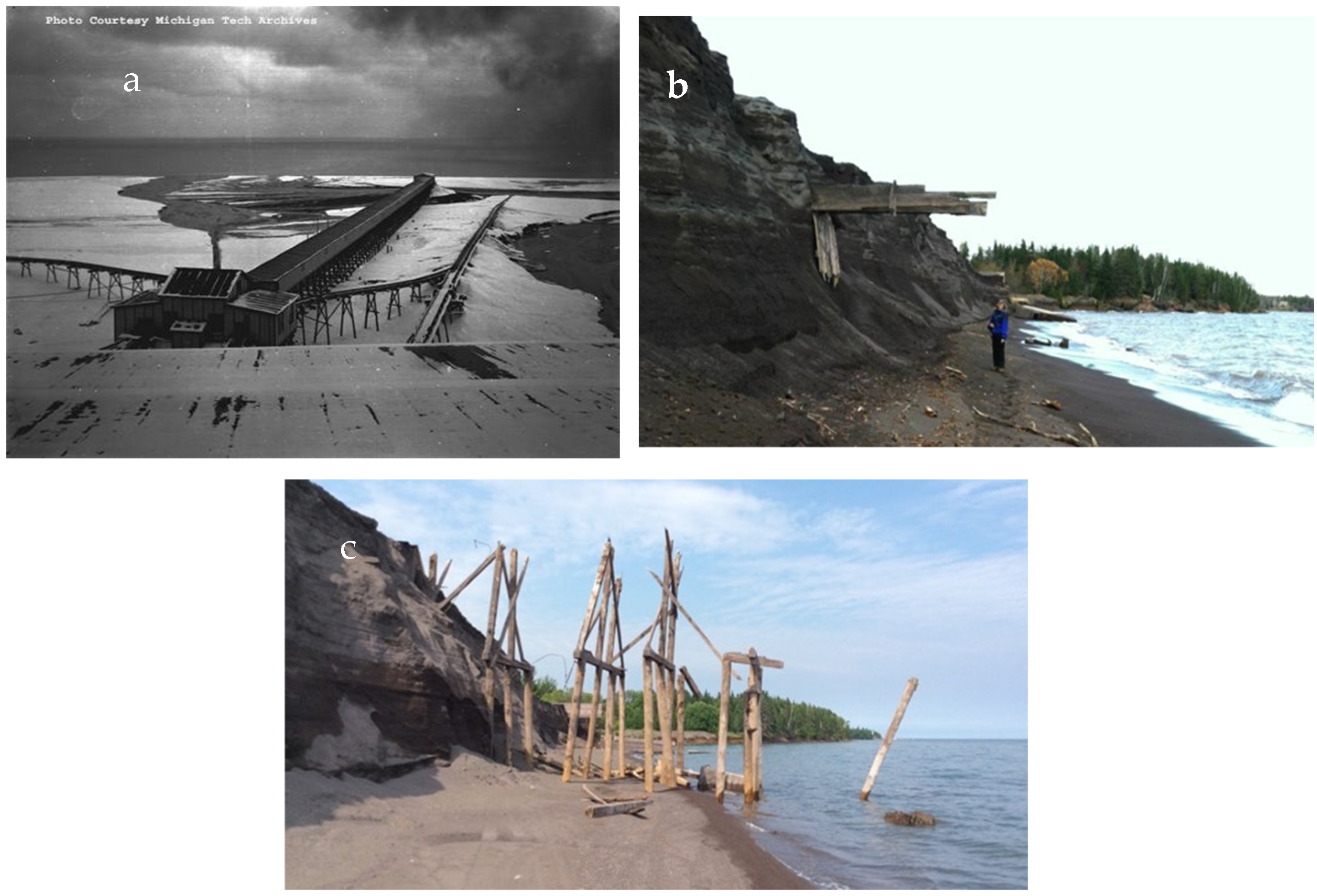
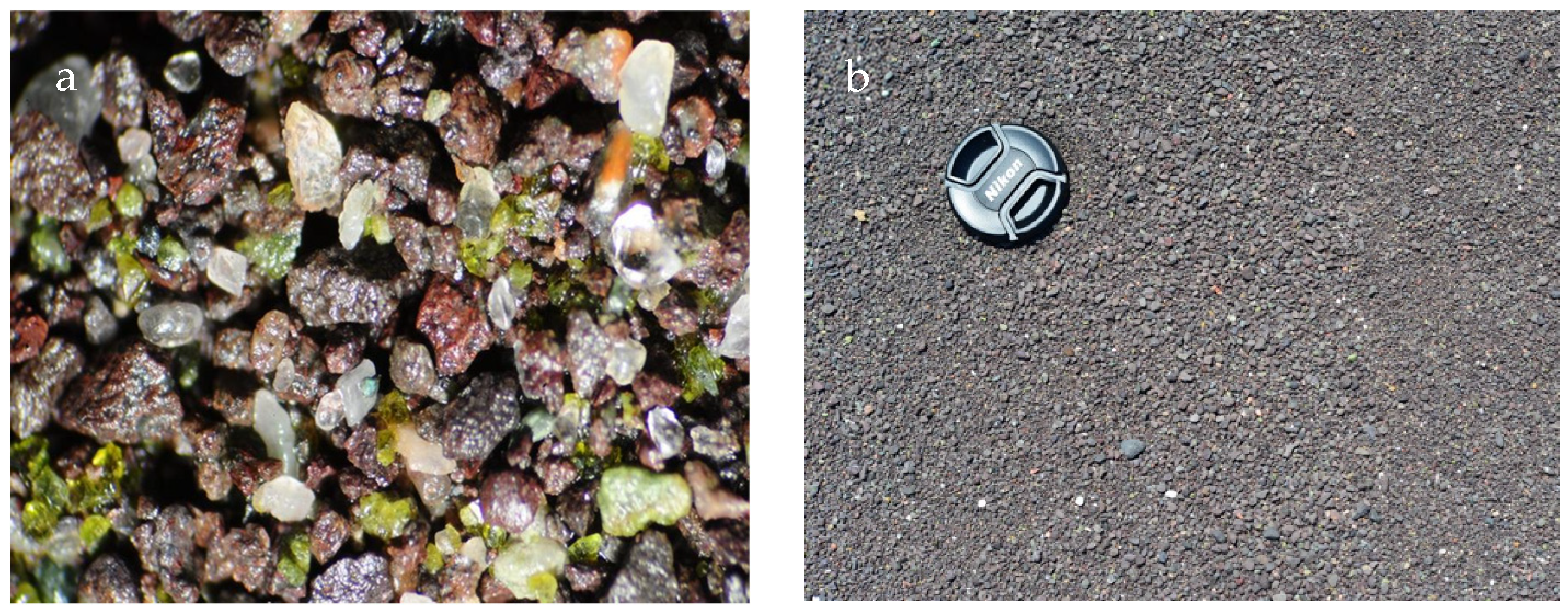

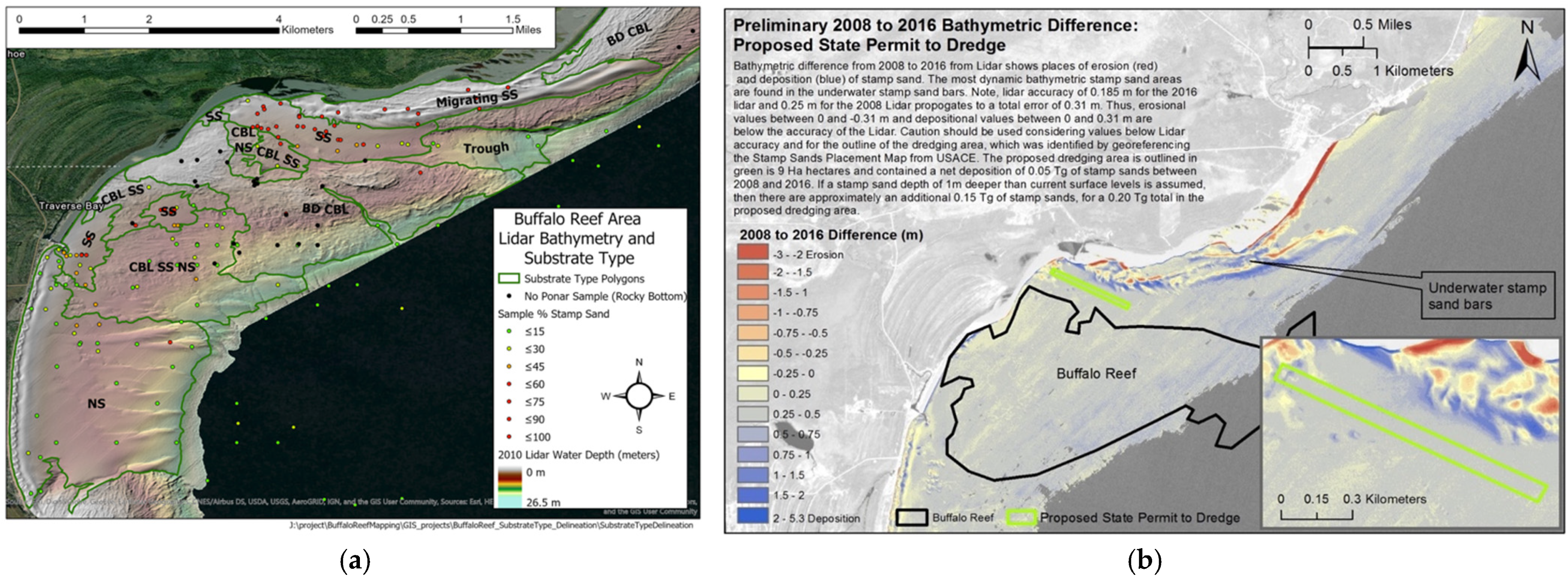

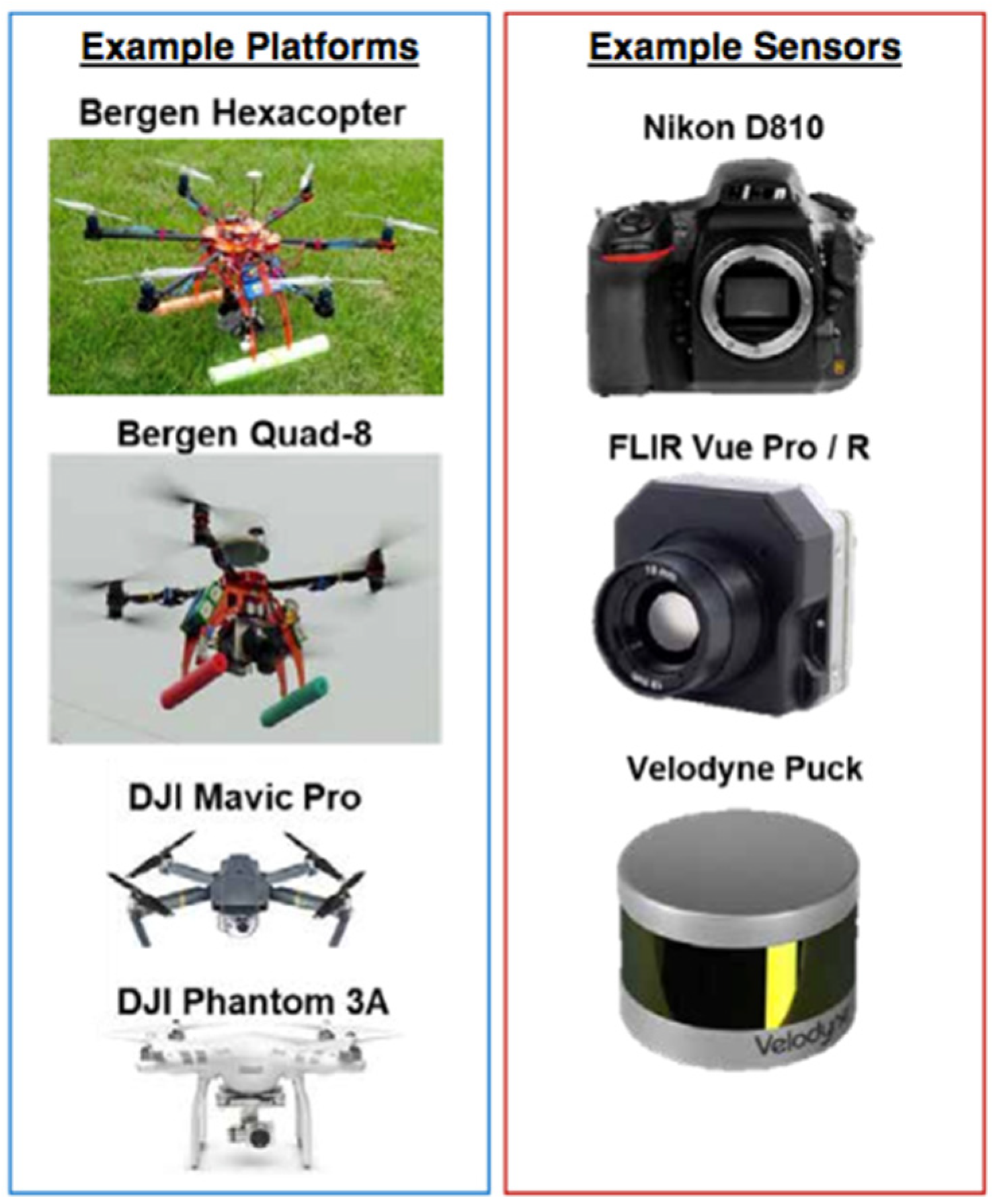
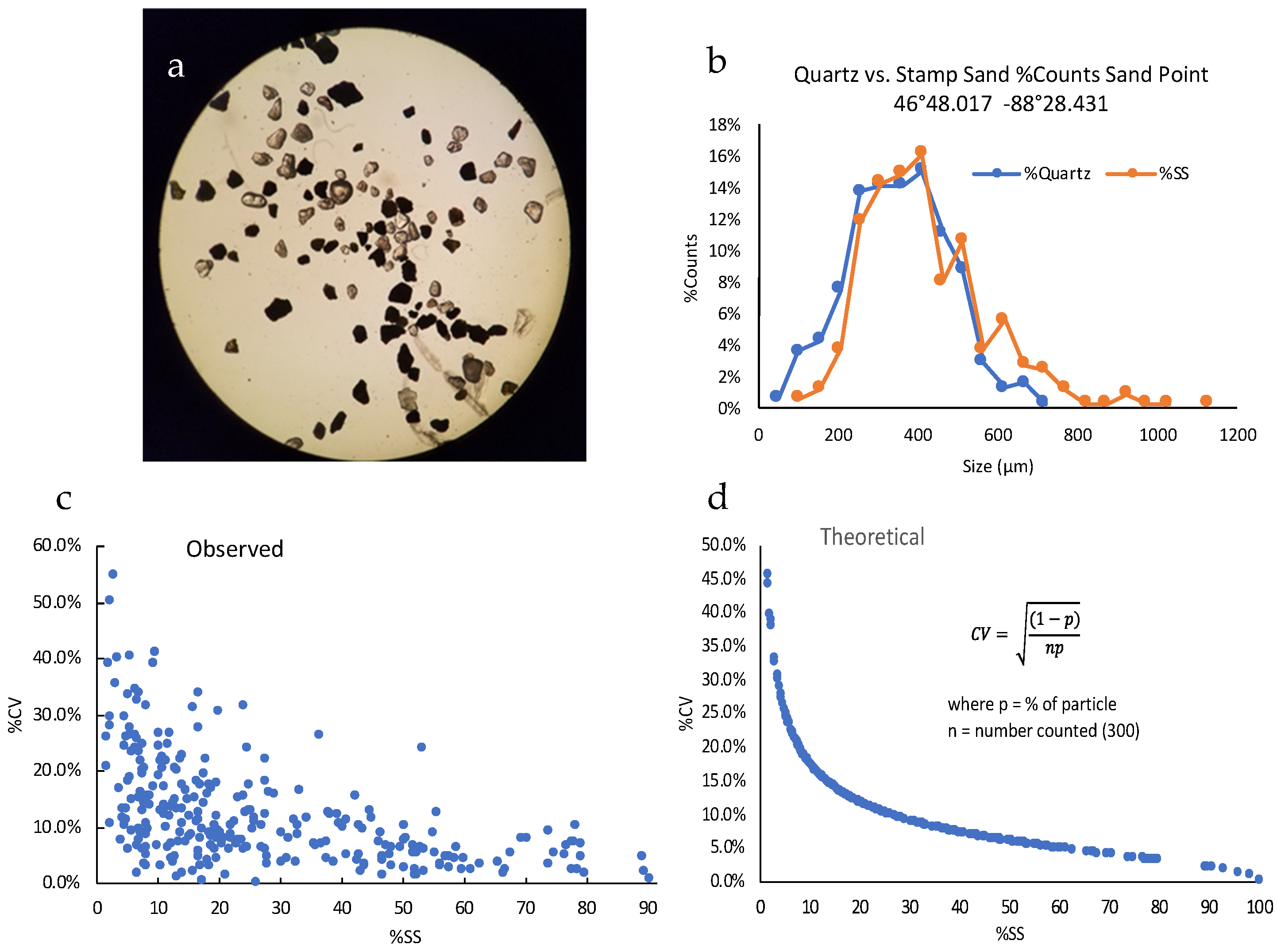

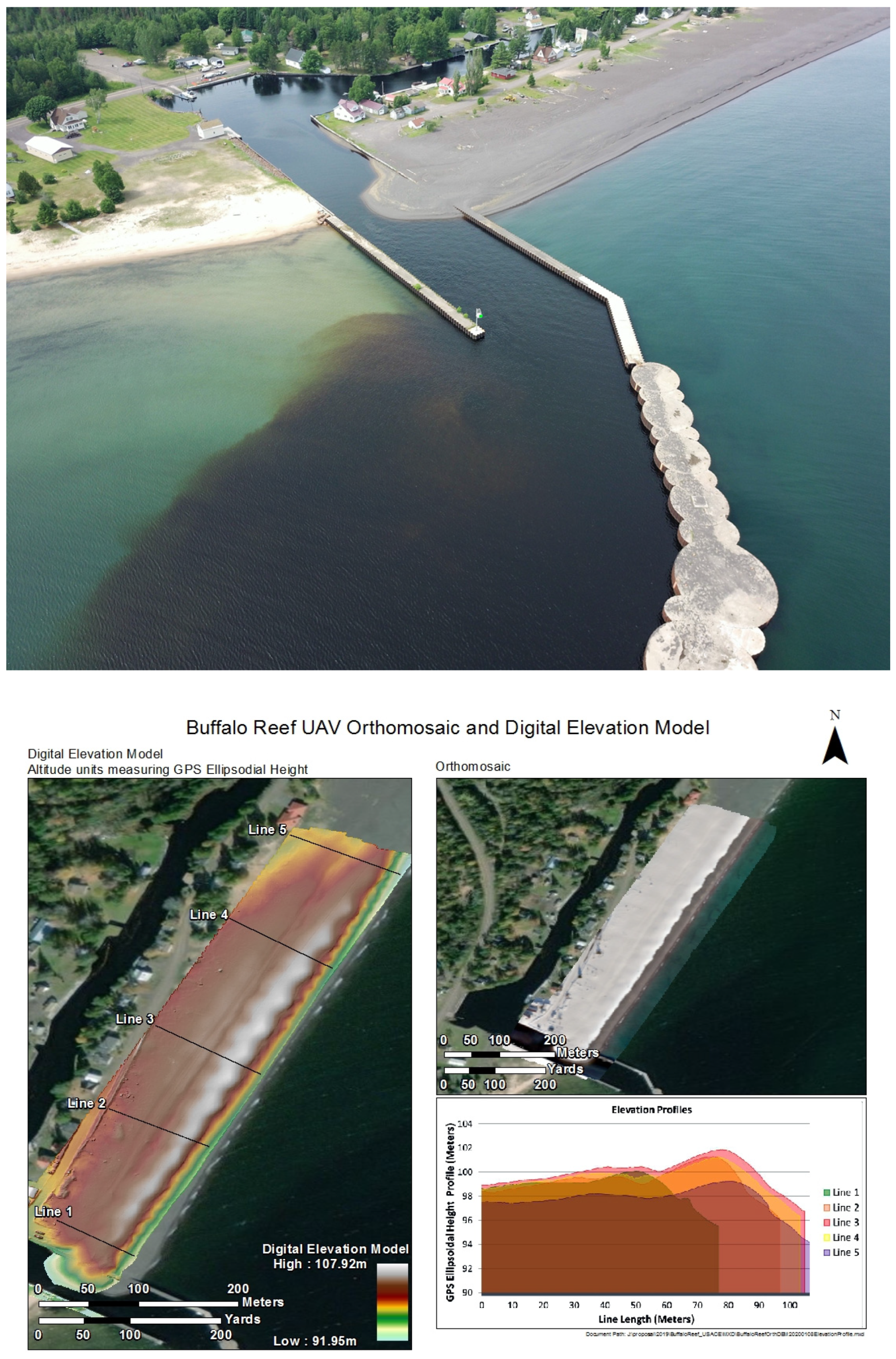

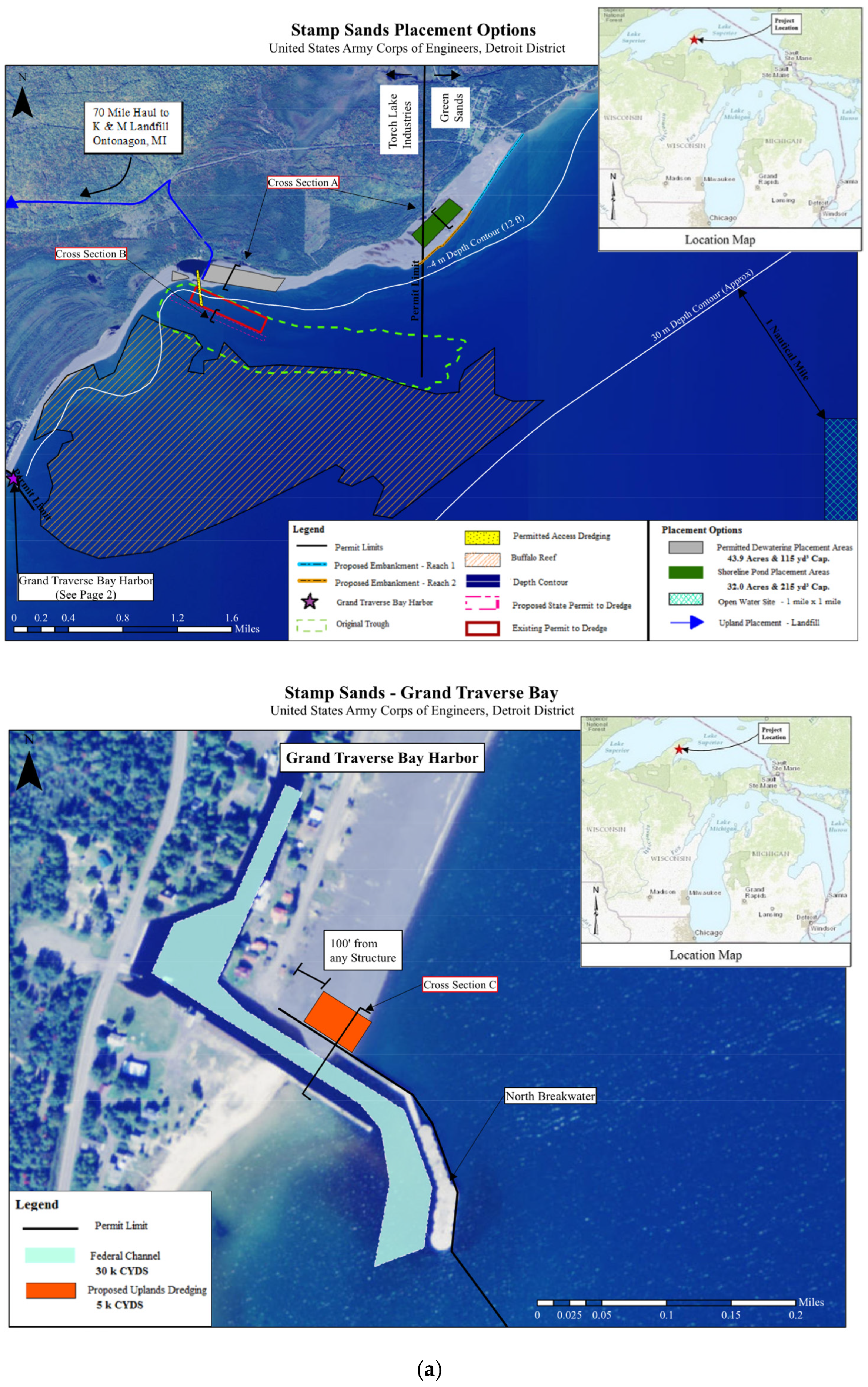
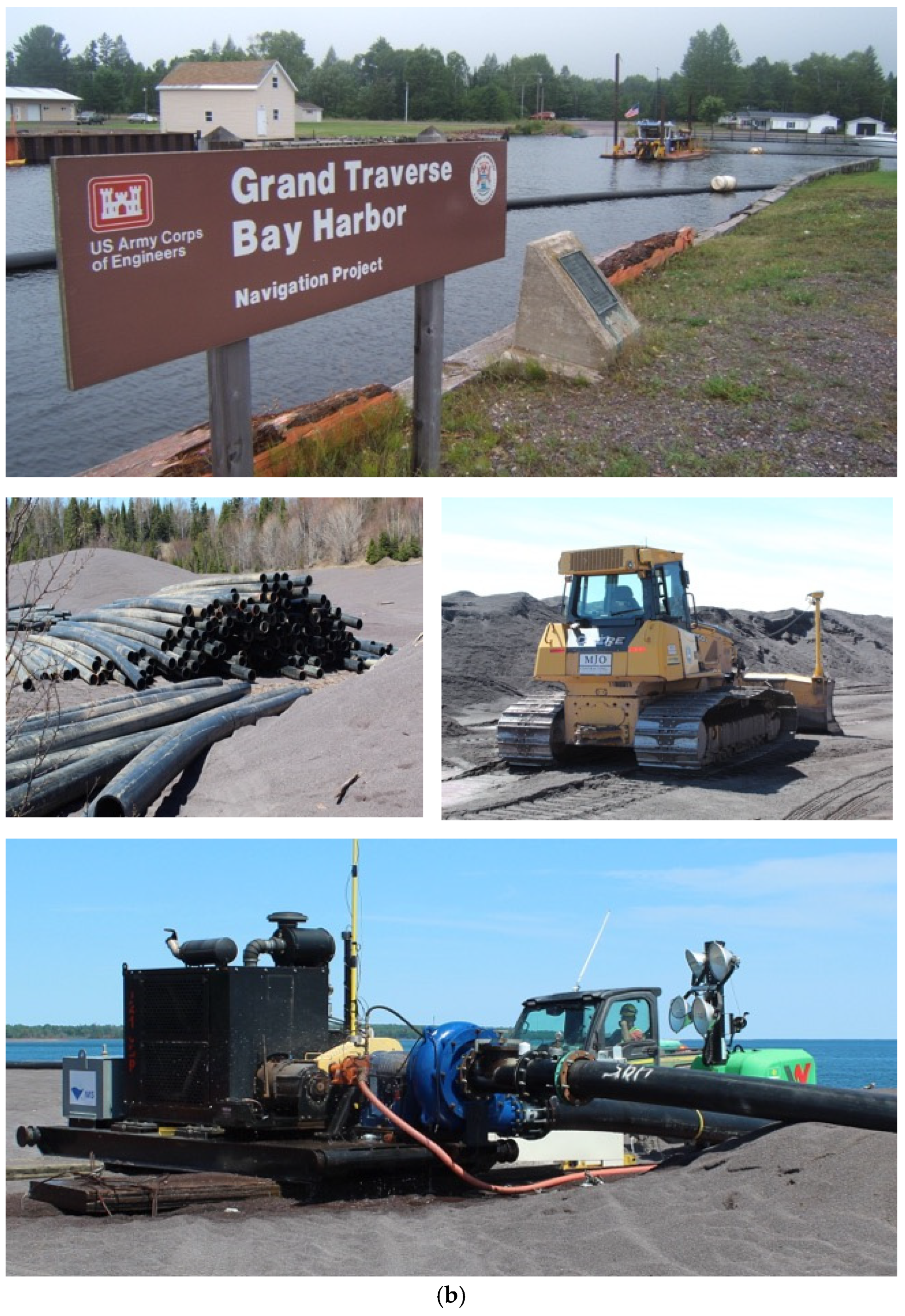
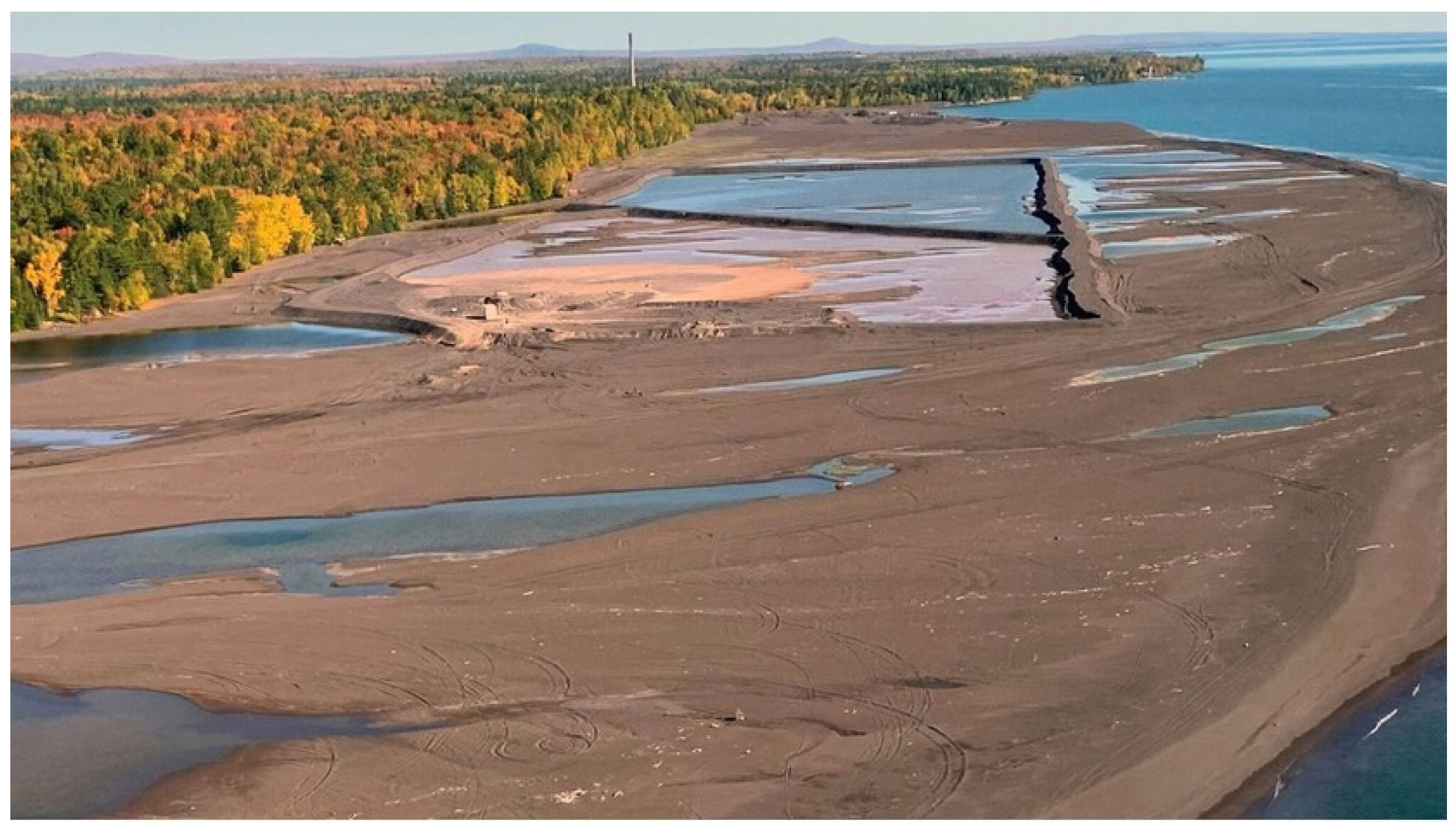
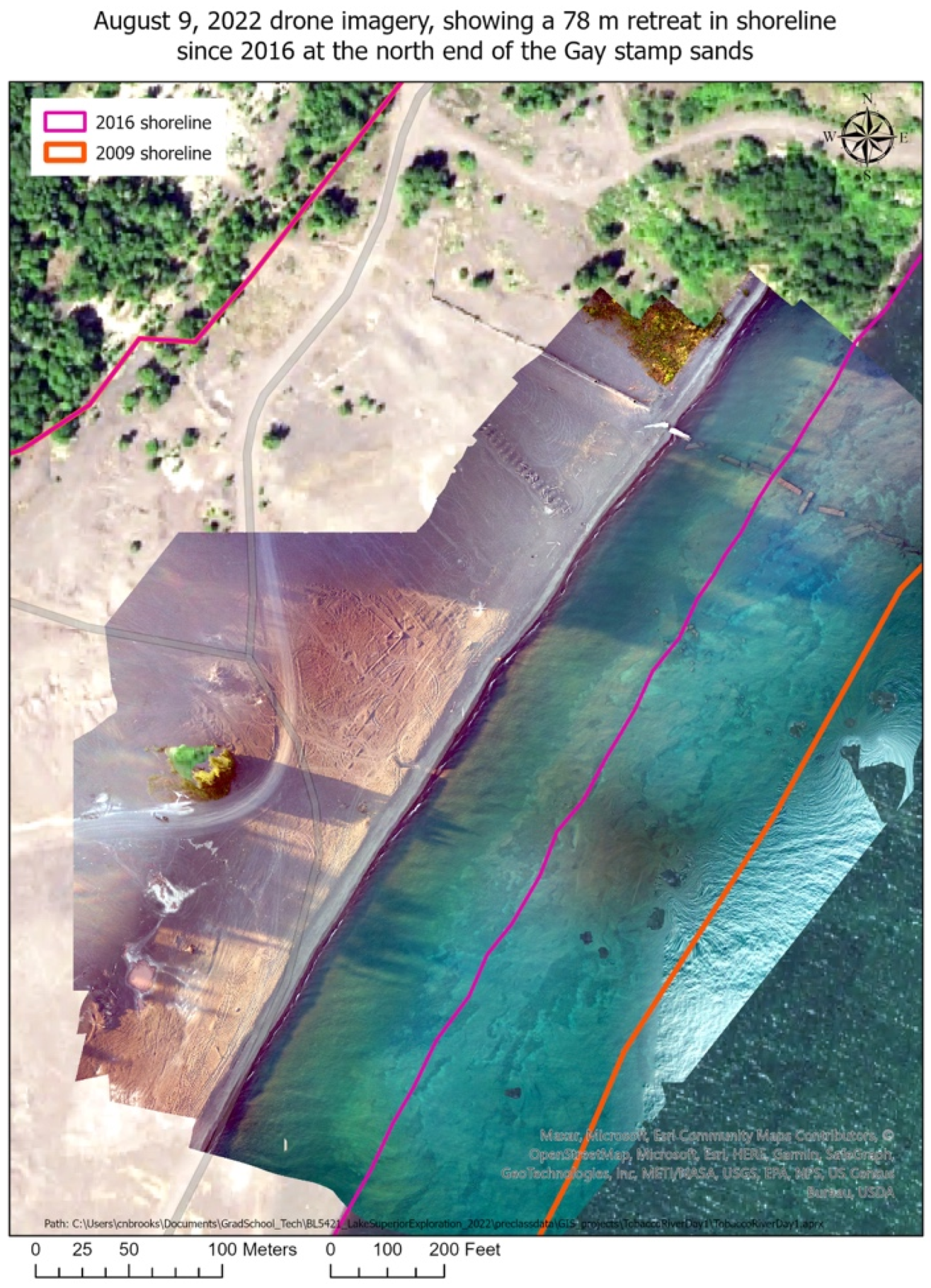


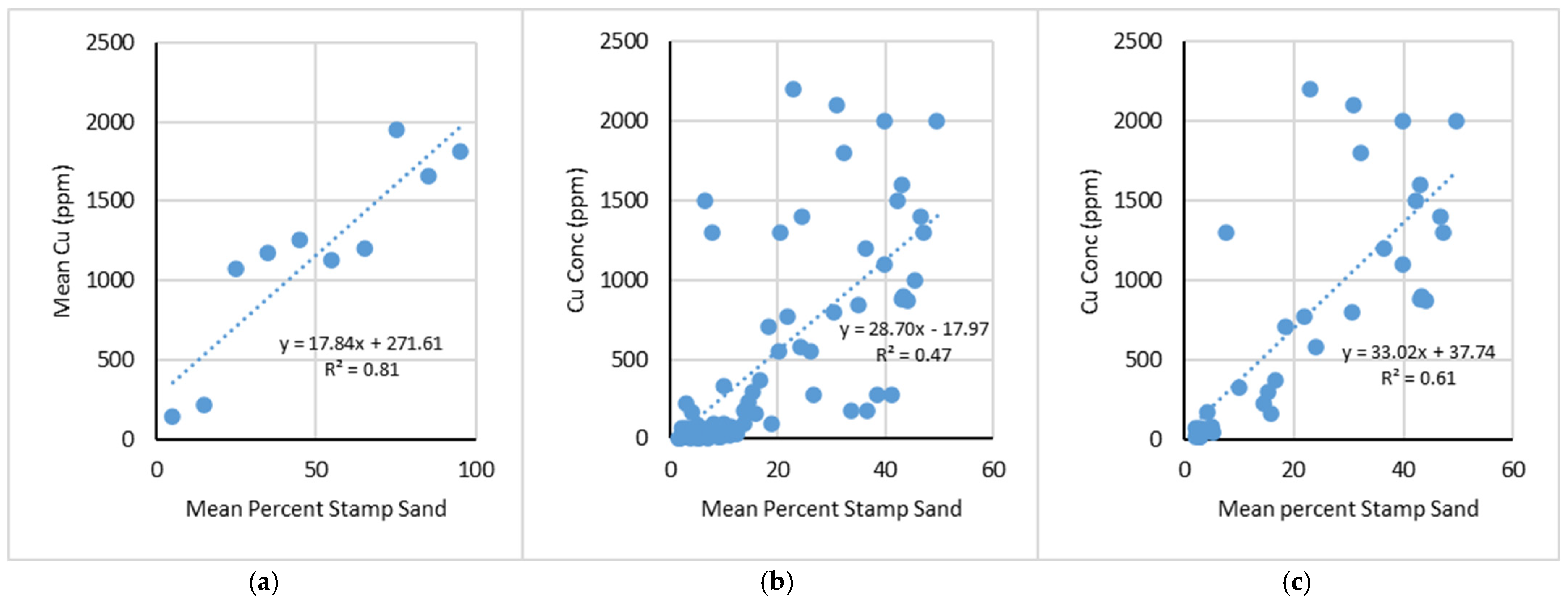
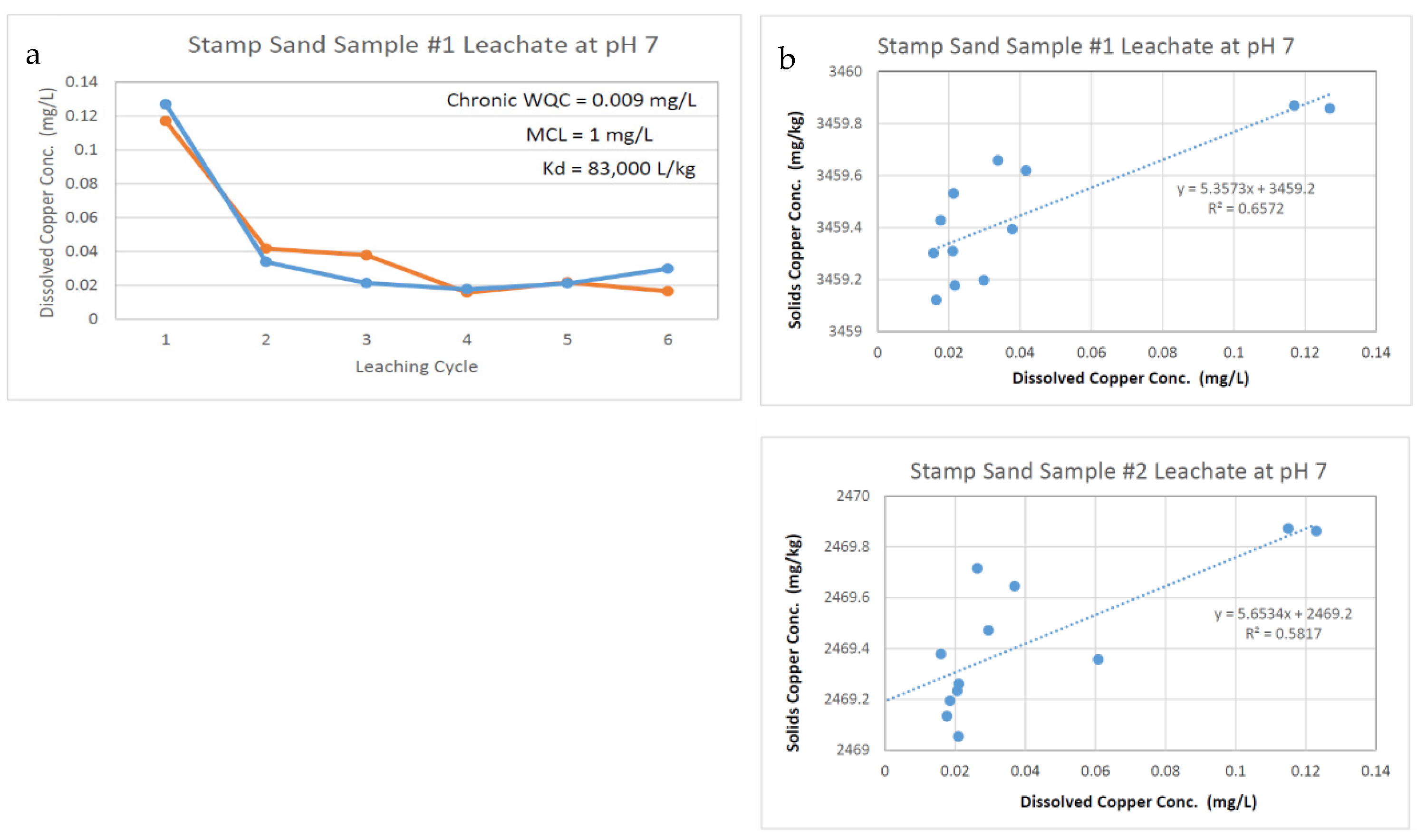
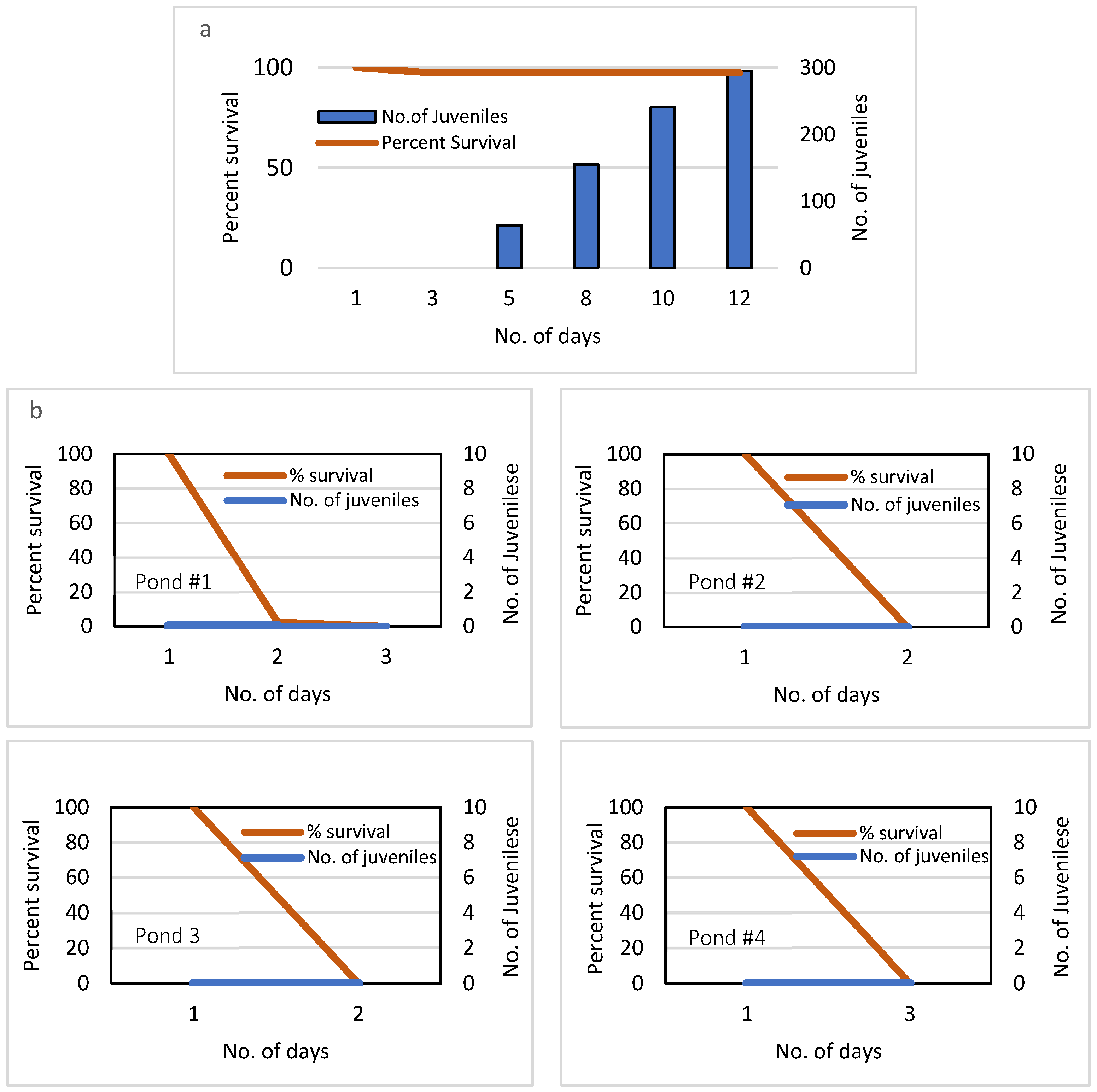
| Site | Years | Ore Grade (%) | Tailings | Metals | (Interstitial, ppb). | References | Acid Mine Drainage |
|---|---|---|---|---|---|---|---|
| Gay, Keweenaw Peninsula, Michigan, USA | 1901–1932 | 1–2% Cu | 22.7 MMT | Cu, Ag | 200–2000 | [7] | No |
| Freda-Redridge, Keweenaw Peninsula, Michigan, USA | 1901–1947 | 1–2% Cu | 42.8 MMT | Cu, Ag | NR. | [8] | No |
| Mass Mill, Keweenaw Peninsula, MI, USA | 1901–1919 | 1–2% Cu | 2.7 MMT | Cu, Ag | NR. | [9] | No |
| Island Copper, Rupert Inlet, British Columbia, Canada | 1971–1995 | 27% Cu | 353 MMT | Cu, Ag | 200–500 | [10] | Serious |
| Britannia Mine, Howe Sound, N of Vancouver, British Columbia, Canada | 1904–1974 | 0.01% Cu | 44 MMT | Cu, Zn, Ag | 5–1009 | [11] | Serious |
| Mount Polley Mine Spill, Fraser River, Likely Fjord, British Columbia, Canada | 2014 | 0.9% Cu | 25 Billion Liters | Cu, Zn, As | 200–400 | [12] | NR |
| Potrerillos & El Salvador Mines, Chanaral Bay, Atacama Region, Chile | 1938–1974 | 0.24% Cu | 250 MMT | Cu, As, Zn | 50–2265 | [13,14] | Yes |
| Marcopper Mining, Calancan Bay, Marinduque Island, Luzon, Philippines | 1975–1991 | 0.44% Cu | 200 MMT | Cu, Zn, Pb | 147–1159 | [15] | Yes |
| Cayeli Bakir Mine, Rize, Black Sea, Turkey | 1994–2000 | 1.33% Cu | 103 K/T/yr | Cu, Zn | 34–279 mg/kg (tailings) | [16] | Yes |
| Panguna Mine, Jaba River, Bouginville Island, Papua New Guinea | 1972–1989 | NR | 140 K/day | Cu, Au | 800–1000 | [17] | Yes |
| Metal | Gay Pile Site | Coal Dock Site | Traverse River Site | |||||
|---|---|---|---|---|---|---|---|---|
| INAA#1 | INAA#2 | MDEQ | ERDC-EL | ERDC-EL | NRRI | MDEQ | ERDC-EL | |
| Aluminum (%) | 6.4 (03) | 6.6 (0.3) | 16 | 12.7 | 14.7 | NR | 11.8 | 13.8 |
| Arsenic (ppm) | 4.0 (0.7) | 3.0 (0.6) | 3.1 (1.6) | 5.7 | 5.52 | 4.8 (0.5) | 1.6 | 6.39 |
| Barium (ppm) | 320 (39) | 273 (42) | 3.6 (1.6) | NR | NR | 204 (11) | NR | NR |
| Cadmium (ppm) | NR | NR | NR | 0.544 | 0.462 | NR | NR | 0.405 |
| Calcium (ppm) | NR | NR | NR | 18,100 | 25,000 | NR | NR | 32,200 |
| Chromium (ppm) | 105 (4) | 96 (4) | 22 (5) | 24 | 22.3 | 22 (5) | 29 | 15.8 |
| Cobalt (ppm) | 34.7 (1.0) | 58.2 (1.7) | 23 | 26.4 | 31.3 | 33.9 (1.6) | 19 | 29.4 |
| Copper (ppm) | 1620 (220) | 1980 (270) | 2731 (2793) | 3460 | 2470 | 2675 (699) | 1713 | 2810 |
| Iron (%) | 8.1 (0.05) | 7.8 (0.05) | NR | NR | NR | NR | NR | NR |
| Lead (ppm) | NR | NR | 6.9 (1.1) | 2.39 | 3.1 | 5.0 (0.6) | ND | 3.2 |
| Lithium (ppm) | NR | NR | NR | 6.05 | 6.23 | NR | 5.8 | 5.59 |
| Magnesium (ppm) | NR | NR | NR | 16,300 | 27,800 | NR | NR | 16,100 |
| Manganese (ppm) | 1031 (23) | 1026 (23) | 549 | 389 | 459 | NR | 407 | 427 |
| Mercury (ppm) | NR | NR | 0.029 | 0.007–0.003 | 0.0145–0.0582 | 0.02 (0.01) | ND | 0.01–0.07 |
| Potassium (%) | 0.9 (0.1) | 0.9 (0.1) | NR | NR | NR | NR | NR | NR |
| Nickel (ppm) | NR | NR | 26.8 (4.8) | 25 | 26 | 47.8 (4.4) | 27 | 24.4 |
| Selenium (ppm) | NR | NR | NR | 1.9 | 16.3 | NR | NR | 20.8 |
| Strontium (ppm) | NR | NR | NR | 11.6 | 19.7 | NR | 13 | 21.6 |
| Thallium (ppm) | NR | NR | NR | 1.94–2.12 | NR | NR | NR | 2.37–2.59 |
| Titanium(ppm) | 8109 (590) | 9656 (724) | NR | NR | NR | NR | NR | NR |
| Uranium (ppm) | 0.4 (0.0) | 0.6 (0.1) | NR | NR | NR | 0.7 (0.1) | NR | NR |
| Zinc (ppm) | 98.5 (9.0) | 51.8 (6.6) | 71.4 (11.0) | 57.9 | 68.7 | 81.5 (14.4) | 66 | 59.6 |
| Source | N | R2 | Regression Equation | 100% SS Intercept (ppm) |
|---|---|---|---|---|
| Initial Cu Calibration Kerfoot 2021 | 40 | 0.867 | Y = 25.066X − 156.43 | 2350 |
| AEM Group Mean Regression, All SS | 10 | 0.812 | Y = 17.838X + 271.61 | 2055 |
| AEM Group, All Under 50% SS | 63 | 0.475 | Y = 28.699X − 17.965 | 2852 |
| Along Shoreline Under 50% SS | 36 | 0.61 | Y = 33.019X + 37.744 | 3340 |
| Water Source | Concentrations After Agitation | |||
|---|---|---|---|---|
| Al 394 (ppb) | Cu 327 (ppb) | Fe 238 (ppb) | TOC (mg/L) | |
| Lake Superior (LS) | 480 | 330 | 933 | 1.8 |
| Bete Grise (BG) | 525 | 515 | 527 | 1.5 |
| Portage Lake (PL) | 510 | 330 | 760 | 1.5 |
| Traverse River (TR) | 430 | 550 | 853 | 13.9 |
| Coal Dock (CD) | 520 | 515 | 739 | 21.2 |
| Site | CU Measure | Size | pH 4.2 | pH 4.2 + DOC |
|---|---|---|---|---|
| Gay Pile | Filtered Cu | Coarse Sand | 0.0523 | |
| Gravel | 0.09725 | |||
| Total Cu | Coarse Sand | 0.0628 | ||
| Gravel | 0.0611 | |||
| Coal Dock | Filtered Cu | Medium Sand | 0.243 | 1.29 |
| Total Cu | Medium Sand | 0.35 | ||
| Filtered Cu | Coarse Sand | 0.171 | 1.17 | |
| Total Cu | Coarse Sand | 0.176 | ||
| Filtered Cu | Gravel | 0.146 | 1.45 | |
| Total Cu | Gravel | 0.101 | ||
| Traverse River | Filtered Cu | Medium Sand | 0.115 | |
| Coarse Sand | 0.04145 | |||
| Gravel | 0.0784 |
| Pond Number | Latitude | Longitude | Al (ppb) | Cu (ppb) |
|---|---|---|---|---|
| P1 | 47.16781667 | −88.17075000 | 70 | 990 |
| P2 | 47.21850000 | −88.17008333 | 50 | 270 |
| P3 | 47.21896667 | −88.16863333 | 40 | 120 |
| P4 | 47.21825000 | −88.16753333 | 50 | 80 |
| P5 | 47.21736667 | −88.16800000 | 10 | 70 |
| P5B | 47.21653333 | −88.16900000 | 10 | 60 |
| P6 | 47.21605000 | −88.16833333 | 20 | 50 |
| P7 | 47.21551667 | −88.17040000 | 20 | 90 |
| P8 | 47.21671667 | −88.16781667 | 130 | 200 |
| P9 | 47.21713333 | −88.17045000 | 150 | 2580 |
| P10 | 47.21441667 | −88.17800000 | 80 | 950 |
| P11 | 47.21463333 | −88.17698333 | 290 | 940 |
| P12 | 47.21346667 | −88.17868333 | 30 | 860 |
| P13 | 47.21398333 | −88.17888333 | 30 | 790 |
| Mean Concentration (SD) | 70.0 (76.3) | 575 (696.7) | ||
| Species | N | LD50 (ppb Cu) |
|---|---|---|
| Ceriodaphnia reticulata | 1 | 5.2 |
| Daphnia ambigua | 1 | 24.8 |
| Daphnia magna | 12 | 18.1 |
| Daphnia parvula | 1 | 26.4 |
| Daphnia pulex | 2 | 8.8 |
| Daphnia pulicaria | 8 | 9.3 |
| Daphnia pulex * | 3 | 7.7 |
| Benthic Invertebrates | ||
|---|---|---|
| Species | N (Cases) | 48 h LD50 |
| Alona affinis (benthic cladoceran) | 1 | 386.3 |
| Simocephalus serralatus (benthic cladoceran) | 3 | 95.9 |
| Acroncyria lycorias (stonefly) | 1 | 10,242 |
| Chironomus deorus (midge) | 1 | 833.6 |
| Chironomus riparius (midge) | 1 | 247.1 |
| Cranconyx pseudogracilis (amphipod) | 1 | 1290 |
| Echinogammarus berilloni (amphipod) | 1 | 69 |
| Gammarus pseudolinnaeus | 1 | 22.1 |
| Gammarus pulex | 7 | 31 |
| Fish (salmonid) | ||
| Species | N (cases) | 48 h LD50 |
| Oncorhynchus clarki (cutthroat trout) | 9 | 66.6 |
| Oncorhynchus kisutch (coho salmon) | 3 | 87 |
| Oncorhynchus mykiss (rainbow trout) | 39 | 38.9 |
| Oncorhynchus tsawytscha (sockeye salmon) | 10 | 42.3 |
| Salvelinus fontinalis (brook trout) | 1 | 110.4 |
Disclaimer/Publisher’s Note: The statements, opinions and data contained in all publications are solely those of the individual author(s) and contributor(s) and not of MDPI and/or the editor(s). MDPI and/or the editor(s) disclaim responsibility for any injury to people or property resulting from any ideas, methods, instructions or products referred to in the content. |
© 2025 by the authors. Licensee MDPI, Basel, Switzerland. This article is an open access article distributed under the terms and conditions of the Creative Commons Attribution (CC BY) license (https://creativecommons.org/licenses/by/4.0/).
Share and Cite
Kerfoot, W.C.; Swain, G.; Regis, R.; Raman, V.K.; Brooks, C.N.; Cook, C.; Reif, M. Coastal Environments: LiDAR Mapping of Copper Tailings Impacts, Particle Retention of Copper, Leaching, and Toxicity. Remote Sens. 2025, 17, 922. https://doi.org/10.3390/rs17050922
Kerfoot WC, Swain G, Regis R, Raman VK, Brooks CN, Cook C, Reif M. Coastal Environments: LiDAR Mapping of Copper Tailings Impacts, Particle Retention of Copper, Leaching, and Toxicity. Remote Sensing. 2025; 17(5):922. https://doi.org/10.3390/rs17050922
Chicago/Turabian StyleKerfoot, W. Charles, Gary Swain, Robert Regis, Varsha K. Raman, Colin N. Brooks, Chris Cook, and Molly Reif. 2025. "Coastal Environments: LiDAR Mapping of Copper Tailings Impacts, Particle Retention of Copper, Leaching, and Toxicity" Remote Sensing 17, no. 5: 922. https://doi.org/10.3390/rs17050922
APA StyleKerfoot, W. C., Swain, G., Regis, R., Raman, V. K., Brooks, C. N., Cook, C., & Reif, M. (2025). Coastal Environments: LiDAR Mapping of Copper Tailings Impacts, Particle Retention of Copper, Leaching, and Toxicity. Remote Sensing, 17(5), 922. https://doi.org/10.3390/rs17050922








